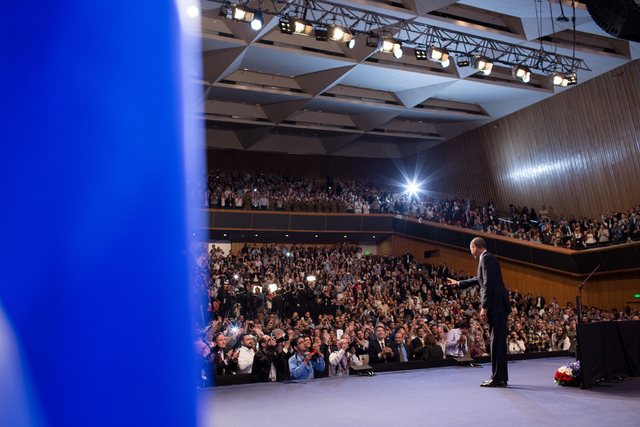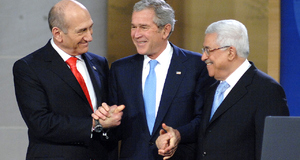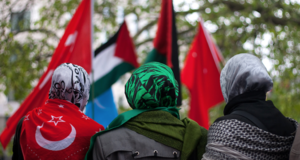The Obama PresidencyExamining the Image of the United States in the Arab World and the Relationship with Israel During the Obama Administration
By
2015, Vol. 7 No. 02 | pg. 1/4 | » For a country approximately the size of New Jersey, Israel certainly garners its share of widespread international attention. It is scrutinized, dissected, and more often than not, demonized under the microscope of the global media. In spite of volatile relations with its neighbors, Israel has maintained a deeply entrenched bond with the United States since President Truman became the first world leader to recognize its existence in 1948. This “special relationship” has not come without costs. U.S. ratings in the Arab world have continued to spiral downward, and the lingering Israeli-Palestinian peace process, whose resolution continues to elude domestic and international efforts, continues to be the dominant source of strain. Can the United States improve its standing in the Arab and Muslim world while maintaining its strategic, political, and moral ties with Israel? In recognizing the interconnectedness between these relationships, this paper takes a “bilateral” approach to these elusive questions by examining President Obama’s outreach to the Arab world during the early years of his presidency through his key speeches, his administration’s relationship with Israel during this period, and where the U.S. currently stands in the region.
I have come here to seek a new beginning between the United States and Muslims around the world; one based upon mutual interest and mutual respect; and one based upon the truth that America and Islam are not exclusive, and need not be in competition. Instead, they overlap, and share common principles – principles of justice and progress; tolerance and the dignity of all human beings. — Barack Obama, Cairo Speech, June 04, 2009, Cairo, Egypt
This is the story of Israel. This is the work that has brought the dreams of so many generations to life. And every step of the way, Israel has built unbreakable bonds of friendship with my country, the United States of America. — Barack Obama, Remarks to the People of Israel, March 21, 2013, Jerusalem, Israel 2009: A Long Road Ahead but a Promising StartPresident Obama certainly had his work cut out for him when he took office in January 2009: Regional median approval of U.S. leadership was just 15% in the predominantly Muslim Middle East and North Africa. A history already replete with strained relations in the region had been exacerbated by the two unpopular wars, a controversial detention facility in Guantanamo Bay, and the continuation of the Arab-Israeli conflict in which the Arab nations continually view the U.S. favoring Israel in its approach. President Obama did, however, have options that would lead to more immediate upticks in ratings: in a January 2009 Foreign Policy Opinion Briefing, Gallup polling of various North African and Middle Eastern countries (including the Palestinian territories) showed pulling out of Iraq and closing the Guantanamo Bay as the factors most likely to improve those countries’ views of the U.S. On the other hand, the complexities of the United States’ deeply embedded relationship with Israel, as well as its involvement in the Israeli-Palestinian peace process, have continually been a source of tension and conflict between the three parties and would require more creative and sustained efforts to increase Arab approval ratings while maintaining the relationship with Israel. New BeginningsIn truly progressive rhetoric, President Obama traveled the Middle East and “campaigned” heavily on the grounds of new beginnings, mutual respect, shared responsibility, and the need to overcome years of distrust through cooperative action and peacemaking—themes that reverberated in many of his globally-minded speeches to come. Days after his inauguration, he gave his first interview to al-Arabiya, an Arab cable TV network. Shortly thereafter, he continued a custom President George W. Bush began in 2008 to reach out to Iranian leaders and the Iranian people on Nowruz, a New Year celebration: So in this season of new beginnings I would like to speak clearly to Iran's leaders. We seek instead engagement that is honest and grounded in mutual respect (…) I want you, the people and leaders of Iran, to understand the future that we seek. It's a future with renewed exchanges among our people, and greater opportunities for partnership and commerce. It's a future where the old divisions are overcome, where you and all of your neighbors and the wider world can live in greater security and greater peace (…) You have that right -- but it comes with real responsibilities, and that place cannot be reached through terror or arms, but rather through peaceful actions that demonstrate the true greatness of the Iranian people and civilization.[1] Many of these words and themes carry over to the most documented speech of President Obama’s early outreach approach: His June 2009 speech at Cairo University. The address touches on many aspects of the United States’ desire to increase relations with the Arab world; this analysis will address a few key tenets. Departing from the a long-held notion by many Americans- past and present- of American exceptionalism, Obama notably remarked: Given our interdependence, any world order that elevates one nation or group of people over another will inevitably fail. So whatever we think of the past, we must not be prisoners of it. Our problems must be dealt with through partnership; progress must be shared.2 He also emphasized the urgency and importance of action in order to foster better relations, and the consequences of not doing so: Recognizing our common humanity is only the beginning of our task. Words alone cannot meet the needs of our people. These needs will be met only if we act boldly in the years ahead; and if we understand that the challenges we face are shared, and our failure to meet them will hurt us all.[3] Continuing to emphasize the interconnectedness of world issues, President Obama devoted a considerable amount of time discussing the second “major source of tension (…) the situation between Israelis, Palestinians, and the Arab world,” and the mutual interests shared by Israel, Palestine, America, and the world in pursuing a peaceful outcome to the conflict. 4 Although he stressed the “well-known” and “unbreakable” bonds with Israel, it is worthwhile to note that he made no reference of biblical ties to the land. On this bond: It is based upon cultural and historical ties, and the recognition that the aspiration for a Jewish homeland is rooted in a tragic history that cannot be denied (...) Six million Jews were killed – more than the entire Jewish population of Israel today. Denying that fact is baseless, ignorant, and hateful. Threatening Israel with destruction – or repeating vile stereotypes about Jews – is deeply wrong, and only serves to evoke in the minds of Israelis this most painful of memories while preventing the peace that the people of this region deserve. President Obama also underscored the plight and suffering of the Palestinian people in the pursuit of a nation-state and the intolerable conditions of the present, declaring, “America will not turn our backs on the legitimate Palestinian aspiration for dignity, opportunity, and a state of their own.” He continues: Israelis must acknowledge that just as Israel's right to exist cannot be denied, neither can Palestine's. The United States does not accept the legitimacy of continued Israeli settlements. This construction violates previous agreements and undermines efforts to achieve peace. It is time for these settlements to stop. The language Obama used when referring to Israeli settlements- denying their legitimacy- sparked much debate, and has continued to affect U.S. policy towards Israel and the peace process, this chapter will later elaborate on the aftermath of these statements. It also warranted a prompt Israeli reply, delivered by Netanyahu three days later to a joint session of Congress. The final speech of Obama’s early presidency this analysis will address is his April 2009 address to the Turkish Parliament. The speech reiterates previously expressed goals- broader engagement based on mutual interest and respect- and also emphasizes urgency of doing so due to global intertwinement: No one nation can confront these challenges alone, and all nations have a stake in overcoming them. That is why we must listen to one another, and seek common ground. That is why we must build on our mutual interests, and rise above our differences. We are stronger when we act together.5 As in his previous speeches to the Arab world, President Obama also shifted focus to the Palestinian-Israeli situation and his determination to foster improvements, noting the “shared goal of a lasting peace between Israel and its neighbors (…) a goal that I will actively pursue as President of the United States.” He emphasized with both sides, expressing empathy towards the plight of the Palestinian people and the duty to strengthen them, while also denouncing the use of terror and stressing the need to recognize the legitimacy of Israel’s security concerns.6 Overall, President Obama’s early speeches convey optimism and hope for the future of U.S. relations in the Arab regions. Have these promises materialized in any capacity, or are they merely conflated rhetoric? President Obama continually stressed the importance and urgency of action, but have his efforts reflected this appeal? In other words, has he “personally pursue(d) (peace between Israel and Palestine) with all the patience that the task requires?” One cannot make conclusions about U.S. image in the Arab world without first examining President Obama’s approach to relations with Israel during his presidency.Continued on Next Page » Suggested Reading from Inquiries Journal
Inquiries Journal provides undergraduate and graduate students around the world a platform for the wide dissemination of academic work over a range of core disciplines. Representing the work of students from hundreds of institutions around the globe, Inquiries Journal's large database of academic articles is completely free. Learn more | Blog | Submit Latest in Political Science |


















